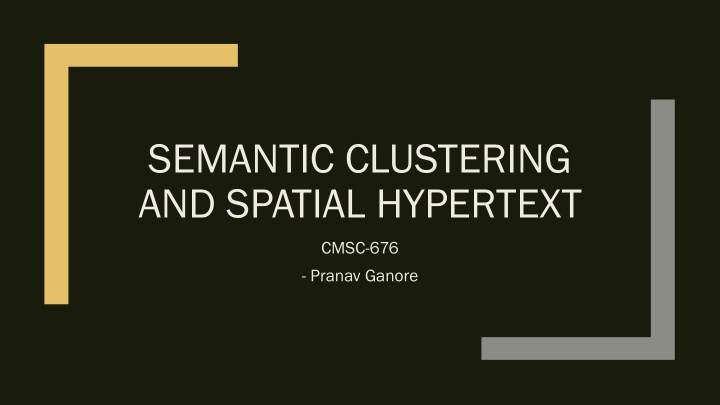



SEMANTIC CLUSTERING AND SPATIAL HYPERTEXT CMSC-676 - Pranav Ganore
INTRODUCTION: Spatial Hypertext ■ Hypertext is text which contains links to other texts. ■ The term was coined by Ted Nelson around 1965. ■ What is its most famous implementation ? ■ What is Spatial Hypertext ? And why it emerged ? – Widespread use of hypertext led to readers getting lost or confused. – NoteCard’s (Browser Card’s) – network map rather than document viewer. – gIBIS , Aquanet – visual networks containing typed links and nodes. – Move from document centered hypertext systems to Map based hypertext systems. – Relationship between nodes & Node P Proximity. – VI VIKI/VK VKB, , StoryS ySpace, , Ti Tinde derBox
It takes advantage of Visual Memory & Pattern Enables the expression of Benefits of people's considerable Recognition relation variations visual recognition and intelligence Spatial Hypertext. It facilitates constructive It supports emerging It reduces overhead in ambiguity problem-solving strategies communicating with others
INTRODUCTION: Semantic Clustering Sem emanti tic Clus usteri ering The e higher er th the e num umber er of of When en is Sem emanti tic group oups sem emanti tically ques uesti tion ons, wor ords ds and d Clus usteri ering us used? ed? eq equi uivalen ent t sea earch queri ueries es phra rases es with th a similar r — wor ords ds, phra rases es and d mea eaning, th the e grea reater er th the e Unsatisfactory search results ? sen enten ences es — into o clus uster ers clus uster er. – customers react negatively !! based ed on on mea eaning. No precise/incorrect answers for clusters - Serve as good indicators of missing information.
Generative Semantic Clustering in Spatial Hypertext Need to discover methods for generating A Generative System Information Triage semantically meaningful document layouts – Ideally collects articles & elements that - The process of sorting through relevant to help people organize information are most relevant to the user and organize materials and organizing them to meet the according to their own significant criteria. these elements to facilitate browsing, needs of the task at hand. understanding & discovering.
Inform ormation on Tri riage defined as the process of sorting through relevant materials and organizing them to meet the needs of the task at hand. Processes Individual & Context specific involved: Approach Quantifying distinguishing useful features.
System for browsing, searching, and collecting information elements in an information space. CombinFormation Initiatives : System’s generative actions & User’s direct manipulation actions. A mixed initiative system Proactively collects information from https://ecologylab.net/combinFormation/about.html information sources. Concurrently generates a Spatial Hypertext.
Placement Algorithm Generative Semantic Feature Extraction Clustering in Semantic Clustering : Spatial Rel elatedn ednes ess Poten ential Hypertext Interactive Mechanisms : Latching & Re-cluster Operations
■ Suitability of “Relatedness Potential”. ■ Organizes information in Spatial Hypertext with less efforts ■ Can be used to segregate or aggregate the Conclusions information elements from different elements. ■ Can be used to translate an unorganized collection of bookmarks into semantically clustered spatial hypertext . ■ Preliminary evaluations showed participants preferred the clustered documents.
Thank You!!
References ■ Generative Semantic Clustering in Spatial Hypertext. Andruid Kerne, Eunyee Koh, Vikram Sundaram, J. Michael Mistrot Interface Ecology Lab Center for Study of Digital Libraries | Computer Science Department Texas A&M University, College Station, TX 77843, USA ■ Card, S.K., Mackinlay, J.D., Shneiderman, B. Readings in Information Visualization. Using Vision to Think. Morgan Kaufmann Publishers, Inc, San Francisco, CA, 1999 ■ Spatial Hypertext: An Alternative to Navigational and Semantic Links http://cs.brown.edu/memex/ACM_HypertextTestbed/papers/37.html ■ A Spatial Hypertext Wiki for Architectural Knowledge Management | Carlos Solís, ShyWiki Organization, Mexico City, Mexico | csolis@shywiki.org Nour Ali, Muhammad Ali Babar, Lero, University of Limerick, Limerick-Ireland {Nour.Ali, Muhammad.AliBabar}@lero.ie ■ Web Visualization of Temporal and Spatial Health Data from Smartphone App in Smart and Connected Community (SCC) | Sharmin Afroz, Electrical and Computer Engineering, University of Memphis, Memphis, TN 38452 USA, safroz@memphis.edu | Bashir I. Morshed, Electrical and Computer Engineering, University of Memphis, Memphis, TN 38152 USA, bmorshed@memphis.edu ■ https://natematias.com/mapViewer/note.php?id=3271618269 ■ http://www.eastgate.com/storyspace/index.html ■ https://www.csdl.tamu.edu/ensemble/?page_id=123/ ■ https://ecologylab.net/combinFormation/about.html ■ https://www.inbenta.com/en/technology/ai-nlp/semantic-clustering/ ■ https://en.wikipedia.org/wiki/Hypertext
Recommend
More recommend